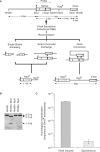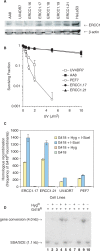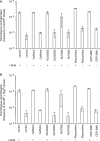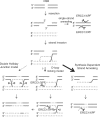The ERCC1/XPF endonuclease is required for efficient single-strand annealing and gene conversion in mammalian cells
- PMID: 17962301
- PMCID: PMC2248766
- DOI: 10.1093/nar/gkm888
The ERCC1/XPF endonuclease is required for efficient single-strand annealing and gene conversion in mammalian cells
Abstract
The mammalian ERCC1-XPF endonuclease has a suggested role in the repair of DNA double-strand breaks (DSB) by single-strand annealing (SSA). Here, we investigated the role of ERCC1 in homologous recombination in mammalian cells, and confirm a role of ERCC1 in SSA. Interestingly, we also report an unexpected role for ERCC1 in gene conversion. This provides support that gene conversion in mammalian somatic cells is carried out through synthesis-dependent strand annealing, rather than through a double Holliday Junction mechanism. Moreover, we find low frequencies of SSA and gene conversion in G1-arrested cells, suggesting that SSA is not a frequent DSB repair pathway in G1-arrested mammalian cells, even in the presence of perfect repeats. Furthermore, we find that SSA is not influenced by inhibition of CDK2 (using Roscovitine), ATM (using Caffeine and KU55933), Chk1 (using CEP-3891) or DNA-PK (using NU7026).
Figures





References
-
- Aboussekhra A, Biggerstaff M, Shivji MK, Vilpo JA, Moncollin V, Podust VN, Protic M, Hubscher U, Egly JM, et al. Mammalian DNA nucleotide excision repair reconstituted with purified protein components. Cell. 1995;80:859–868. - PubMed
-
- van Duin M, Vredeveldt G, Mayne LV, Odijk H, Vermeulen W, Klein B, Weeda G, Hoeijmakers JH, Bootsma D, et al. The cloned human DNA excision repair gene ERCC-1 fails to correct xeroderma pigmentosum complementation groups A through I. Mutat. Res. 1989;217:83–92. - PubMed
Publication types
MeSH terms
Substances
Grants and funding
LinkOut - more resources
Full Text Sources
Other Literature Sources
Molecular Biology Databases
Research Materials
Miscellaneous

